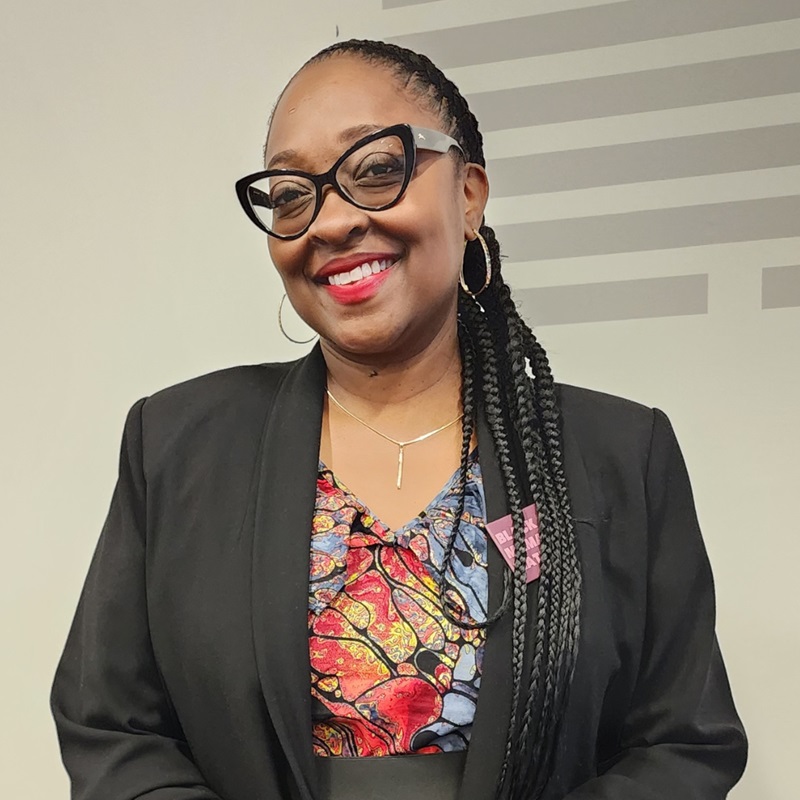HIV in the South & Its Impact on Black Women
Dr. Maisha Standifer of MSM’s Satcher Health Leadership Institute speaks with BlackDoctor.org in honor of Southern HIV Awareness Day.
 Dr. Maisha Standifer
Dr. Maisha Standifer
Director of Population Health, Satcher Health Leadership Institute at Morehouse School of Medicine
By Jasmine Smith, BlackDoctor.org
When we think about the HIV epidemic, the focus often falls on major cities and global initiatives, but there’s an urgent crisis brewing in the South, particularly for Black women. BlackDoctor.org spoke with Dr. Maisha Standifer, a champion of health equity and Director of Population Health at the Satcher Health Leadership Institute at Morehouse School of Medicine, who is on the front lines of this fight. Through her work, she’s tackling the alarming disparities in HIV diagnosis and treatment faced by Black women in the South, using a mix of community outreach, cutting-edge prevention strategies, and advocacy for policy change. Her personal mission? To reshape the narrative around HIV and health care, creating spaces for Black women to thrive despite the odds.
Q: Can you give us an overview of your journey and your current work at the Satcher Health Leadership Institute?
Dr. Standifer: My journey has been one of passion and commitment to public health. I’m currently the Population Health Director at the Satcher Health Leadership Institute at Morehouse School of Medicine, where our focus is on addressing health disparities, particularly in vulnerable and marginalized populations in the South. We’re especially dedicated to combating the ongoing HIV epidemic.
The Institute was founded by Dr. David Satcher, the 16th U.S. Surgeon General, whose work in health equity and social determinants of health has laid the foundation for what we do. Dr. Satcher is not only a scholar and leader, but I also consider him a servant leader in the realms of leadership development, research, and health equity. In addition to being a physician, Dr. Satcher was the Director of the Centers for Disease Control and Prevention, and the former President of Morehouse School of Medicine, as well as Meharry Medical College, alongside Charles R. Drew University of Medicine and Science. Dr. Satcher didn’t just talk about health equity and the importance of addressing disparities—he created real change. Through our partnerships, we continue to promote leadership across various sectors and advocate for evidence-based policies to achieve health equity.
My path led me from the Midwest to Spelman College and Emory University, where I immersed myself in public health, focusing on preventive measures rather than treatment. After earning my PhD in Medical Anthropology, I dedicated my career to addressing health disparities, particularly around HIV prevention and cancer in marginalized communities. I met Dr. Satcher over 20 years ago before the Institute had even been developed. I met him at a function where I was honored as a young scholar in public health. We had a conversation, and I told him, “One day, I would love to work with you.” I didn’t know when that day would come, but it’s incredible that it did.
Q: How does your personal story intersect with your professional work, particularly in public health and population health?
Dr. Standifer: My personal and professional journeys are deeply interconnected. Growing up, I was always passionate about healthcare and initially thought I would become a physician. However, my experiences led me toward public health, where I could focus on prevention and education. My work at the CDC, inspired by leaders like Dr. Satcher, solidified my commitment to addressing health disparities.
Throughout my career, I’ve worked on various public health initiatives, from cancer prevention to HIV education in marginalized communities. This work is not just my job—it’s my personal mission to make a significant impact on the lives of those who are often underserved by the healthcare system.
Q: What are the most significant healthcare disparities you’ve observed between Black and white women when it comes to HIV diagnosis, treatment, and ongoing care?
Dr. Standifer: The disparities are striking and deeply concerning. Black women are nearly 12 times more likely to be diagnosed with HIV than white women. This statistic is critical and underscores the urgency of targeted interventions. Additionally, Black men who have sex with men face an even higher risk, with almost one in two expected to be diagnosed with HIV. These disparities are driven by various factors, including social determinants of health, access to care, and persistent stigma.
Q: Are there efforts to improve the cultural sensitivity of healthcare providers working with patients of color?
Dr. Standifer: Yes, this is a critical focus at Morehouse School of Medicine. We work closely with local and affiliated clinicians to ensure they understand the unique challenges faced by marginalized populations, particularly in areas with high HIV prevalence like metropolitan Atlanta.
We emphasize open dialogue between clinicians and patients, moving beyond just advising patients to building relationships based on trust. Our medical students and PA (Physician Assistant) students are trained in culturally responsive care, which is essential for effectively communicating about HIV prevention and treatment.
We’re also collaborating with other institutions across Georgia to ensure that these efforts extend beyond just the initial clinical visit. This includes developing toolkits and conversation guides for clinicians to use during regular check-ups and making sure HIV prevention is a continual conversation.
Q: What specific prevention strategies do you recommend to address the high rates of HIV among Black women?
Dr. Standifer: For those who are sexually active, there are now medications available, such as PrEP (pre-exposure prophylaxis), that can significantly reduce the risk of contracting HIV. It’s crucial that we get this information out to the communities that need it most, beyond the stigma associated with HIV. It’s important to recognize that anyone who is sexually active is at risk, and taking preventive measures is key.
We need to promote healthy lifestyles and decision-making, especially regarding sexual activity. Today, we have more tools at our disposal than ever before, including injectable medications and oral pills, to prevent HIV. It’s about taking responsibility for one’s health, having self-esteem, and understanding the importance of preventive care.
Moreover, it’s essential to have these conversations in non-traditional settings—like brunches, churches, beauty salons, and family gatherings—to reach people where they are. The message needs to go beyond the clinician’s office and be part of everyday conversations to reduce stigma and new cases of HIV.
Q: What other initiatives are you working on to address health disparities under your leadership?
Dr. Standifer: In addition to our work on HIV prevention, we’re leading the Georgia THRIVES campaign, which aims to improve health outcomes for marginalized communities throughout the state. This campaign involves increasing access to culturally responsive care, enhancing preventive health measures, and reducing the stigma associated with HIV and other health conditions.
We’re also focused on system transformation, advocating for policies that promote health equity. This includes addressing the political determinants of health and advancing mental and behavioral health initiatives. Our goal is to create a more equitable healthcare system that serves all communities, particularly those that have been historically underserved.
Q: Can you discuss some of the latest advancements in HIV prevention and treatment?
Dr. Standifer: PrEP is one of the most significant advancements in HIV prevention. It’s been around for a while, but it’s only recently become more widely recognized and accessible. PrEP is a powerful tool in preventing HIV, especially in populations that are at higher risk, such as Black women and Black men who have sex with men.
We’re also seeing advancements in HIV treatment that allow people diagnosed with HIV to live full, healthy lives. Treatments have evolved to the point where HIV can become undetectable, meaning it can’t be transmitted to others, which is a game-changer for those living with the virus.
However, we need to ensure these advancements are accessible to everyone, regardless of where they live or their socioeconomic status. This involves working with policymakers to secure funding and support for HIV prevention and treatment programs, especially in rural and underserved areas.
Q: As we acknowledge Southern HIV/AIDS Awareness Day, what should our audience know about the importance of this day?
Dr. Standifer: Southern HIV/AIDS Awareness Day is an important opportunity to highlight the ongoing challenges of HIV in the South, where the epidemic is most severe. It’s a day to remember that we’re all in this together, regardless of gender identity, sexual orientation, or background. We need to continue advancing health equity, reducing stigma, and ensuring that everyone has access to the prevention and treatment they need.
At the Satcher Health Leadership Institute, we’re committed to being a transformative force in this fight, and Southern HIV Awareness Day is a reminder of the work still to be done. We’re dedicated to bringing our message beyond metropolitan areas and into the rural, often overlooked communities where education and resources are still needed.
Q: What message do you hope to convey to communities at risk for HIV?
Dr. Standifer: The most important message is one of hope and empowerment. HIV is no longer the death sentence it once was. With the right education, prevention, and treatment, people living with HIV can lead healthy, fulfilling lives. It’s crucial to break down the stigma associated with HIV and encourage open conversations about sexual health, testing, and prevention.
For those who are sexually active, understanding your risk and taking proactive steps, like using PrEP, can make a significant difference. And for those who are diagnosed with HIV, know that there are treatments available that can help you manage the condition effectively.
We must continue to spread this message, particularly in communities where misinformation and stigma are still prevalent. By doing so, we can help reduce the incidence of HIV and improve the quality of life for those living with the virus.

